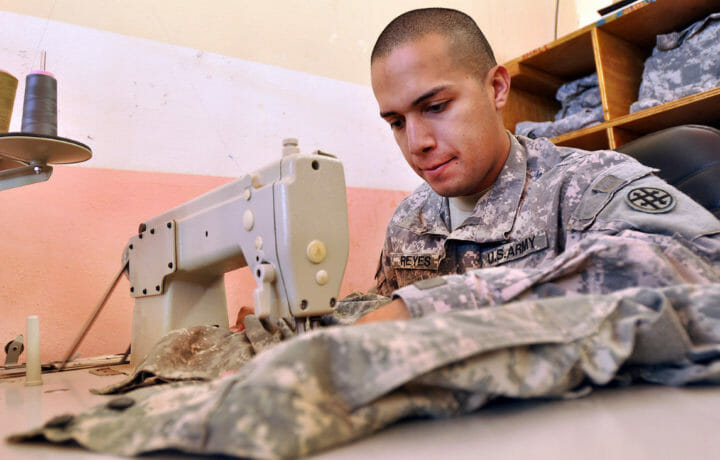Researchers at the Texas A&M’s Department of Mechanical Engineering are working to develop a water-based nanocoating that could be applied to military uniforms. The project, which is being funded by NATO (North Atlantic Treaty Organization), isn’t meant to provide extra ballistic protection, but it could add protective properties from fortification against UV-light and even fire, as well as offering chemical recognition capabilities.
It may seem like a minor consideration, but when adding protective properties to uniforms, the initial benefits could be lost. Thus the military uniform that is made from textiles such as cotton and wool can be less breathable and stiffer when chemicals are added, while nylon that is exposed to a flame retardant can be weakened – so much that it loses its intrinsic properties.
Making the Technology Upgrades work for Military Uniforms
To address those issues, Dr. Jaime Grunlan, the Leland T. Jordan ’29 Chair Professor in the Texas A&M department, has worked to develop a water-based, nontoxic solution that can add those beneficial properties without changing the inherent structure of the clothing. This nanocoating includes non-harmful chemicals such as zinc oxide and titanium oxide and it can be applied by dipping the clothing into a curated solution with a positive charge. After it is extracted it is then placed into a solution with a negative charge.
The attraction of those opposing charges can bond the chemicals, while creating a microscopic nanocoating that adheres to the clothing’s surface in an imperceptible layer. As Texas A&M Today reported, this technique is commonly referred to as pad-dry processing and it can be duplicated with various solutions, and thus create multiple layers with each new deposit, while each solution can also be specifically tailored to add certain qualities to the fabric.
“The chemical detection part is something that is commonly not found in fabrics,” said Dr. Grunlan via a statement. “So if you were starting to be contacted by a chemical agent or something that was dangerous, you could immediately get out of that situation perhaps. So that’s the first line of defense, knowing that you’re in the midst of a certain smoke or something that maybe you can’t even see with your eyes.”
The other benefit of this process is that the chemical makeup of the nanocoatings will reportedly not cause any health issues for the soldiers wearing the clothing or create any environmental damage.
“What people are currently using for flame retardancy,” Dr. Gunlan added. “What people are using for other properties often times have toxicity issues and so on top of having very good properties that we’re going to add to the fabric, we want it to be environmentally benign and toxicity benign, we’re expecting our treatments to be nontoxic.”
Military Solutions and Beyond
What is unique about this process is that not altering the actual fibers, the textile can still remain conformal and as such is seemingly unaffected by the nanocoatings. That further makes the solution environmentally benign as well as cost-effective.
“The new technology developed by Dr. Grulen has unique benefits that make it exceptionally valuable compared to conventional military solutions,” explained technology analyst Charles King of Pund-IT. “For example, typically when you add protective elements or chemicals to clothing material, some benefits of the material can be lost. Soft comfortable cotton often becomes stiff and abrasive, and hot because of reduced air flow. Plus, it is difficult to develop clothing that supports multiple protective features. So flame-proof clothing wouldn’t usually be worn outside situations where fire is a danger.”
By contrast the pad-dry process doesn’t change the core structure.
“It can also be used to create multi-use products,” King told ClearanceJobs. “One development project is a flame-retardant material that also protects the wearer from UV (sunlight) exposure. The material will also change colors if it is exposed to hazardous substances, such as chemical warfare agents. If the project performs as Grulen and his team hope, it could be hugely beneficial for soldiers in numerous military scenarios.”
There are other advantages that such Nanocoatings could provide.
“They are self-cleaning, so they are easier to maintain,” added Rob Enderle, technology analyst at the Enderle Group.
“They can naturally kill bacteria – assuming they use nanosilver – to help prevent wound infections and reduce odors; nanocoatings repel water, yet they still breathe, so your body can still regulate heat through sweat,” Enderle told Clearances. “And they can be made active – per a study out of MIT – allowing them to heat or cool depending on the need; range is 64 degrees to 104 degrees Fahrenheit. Thus, they would have lower maintenance costs, far less need for cleaning; better during an injury, and better able to deal with heat and cold than current uniform materials if active technology is applied.”
Grunlan has already expressed hope that this technology could be used to extend the improvements of military clothing to other areas that could benefit from protective clothing, such as children’s sleepwear or oil field uniforms. However, there could be some issues to consider.
Historically, chemical treatments to clothing in the past have been linked to ailments, but Grunlan has countered that the water-based nature of the nanocoating solution could negate that problem and make it safe for widespread use.
“Nanocoated cloth is a relatively new technology,” noted Enderle. “There may be risks to using this we don’t know yet.”




